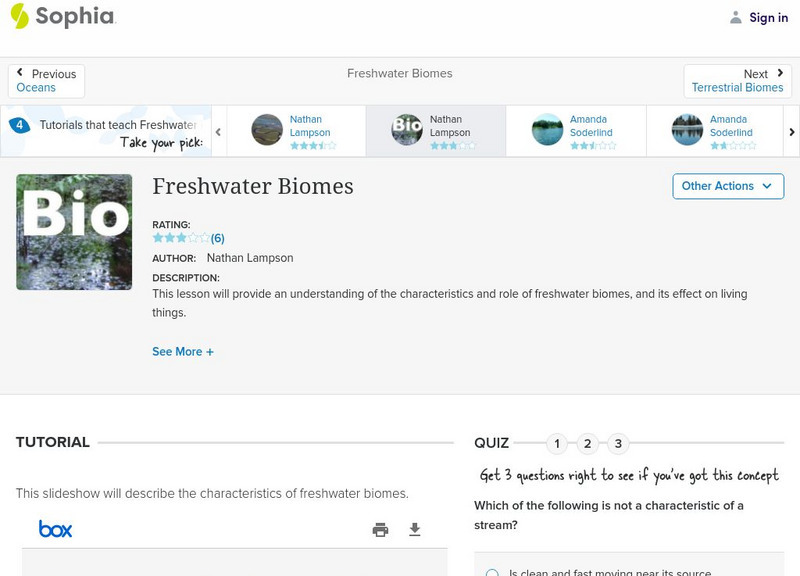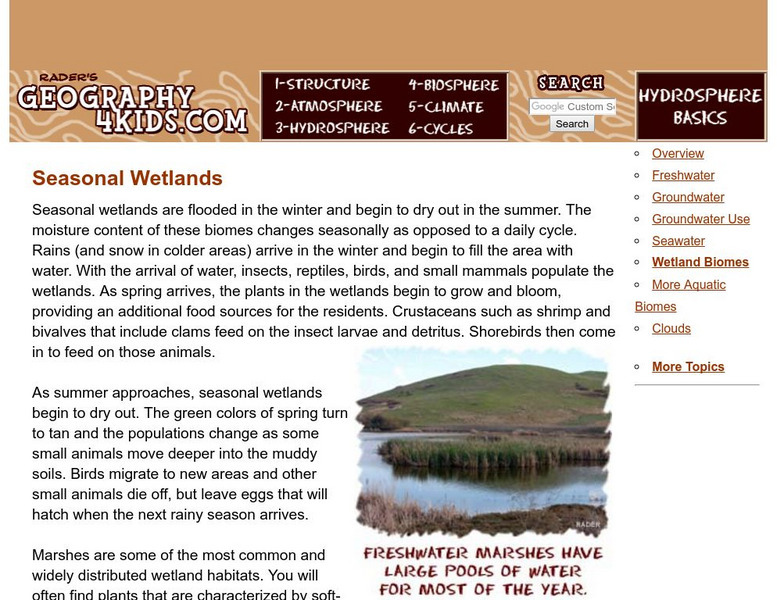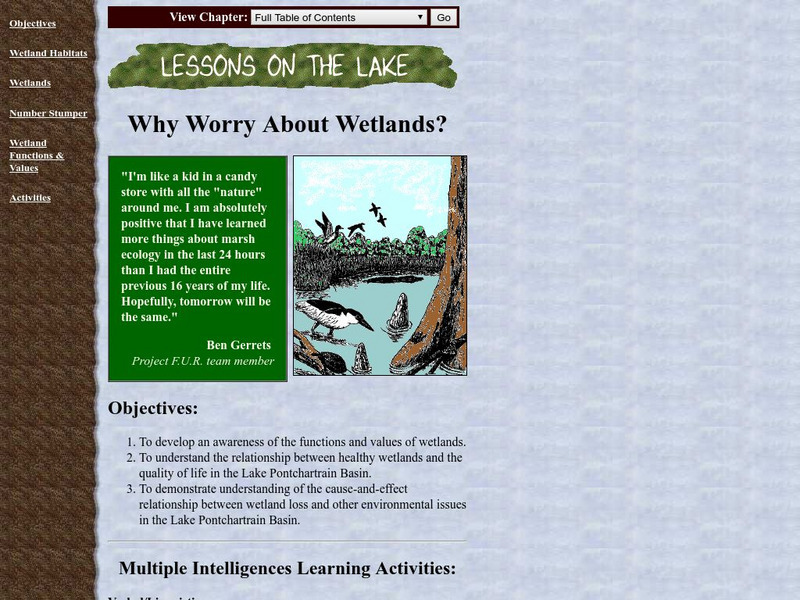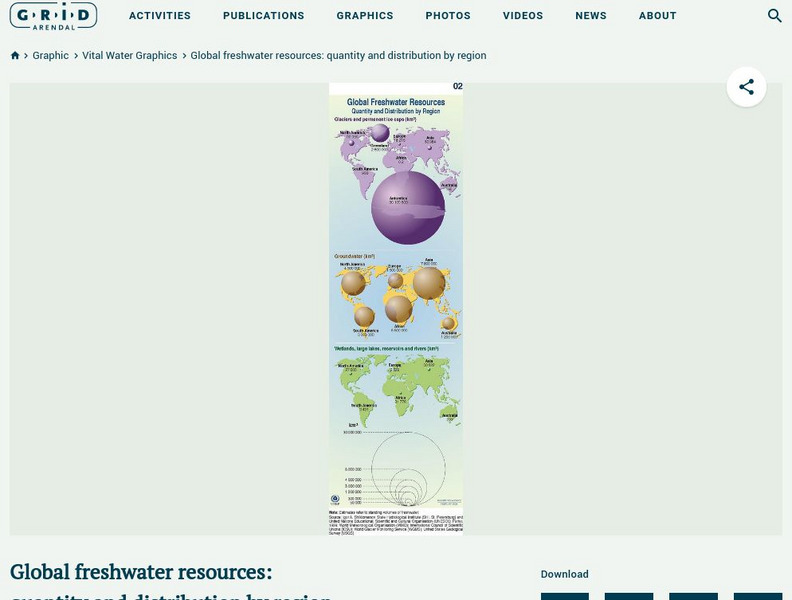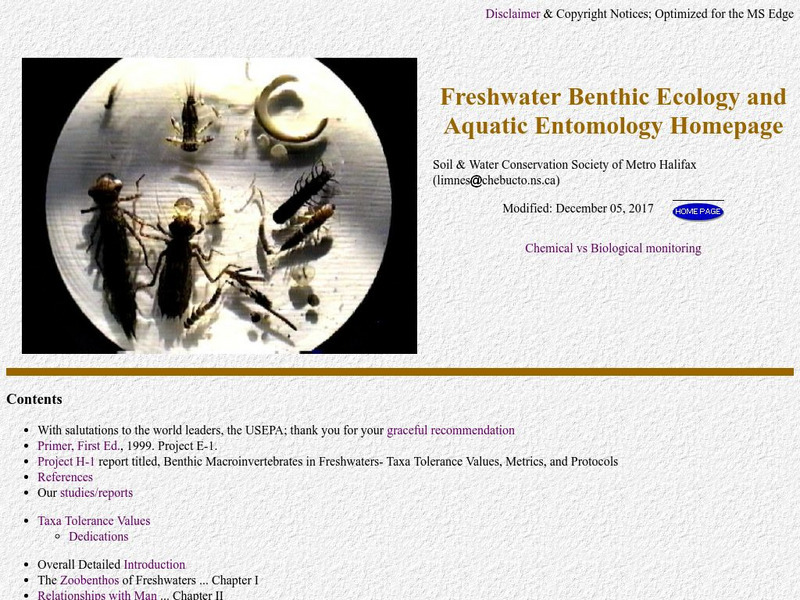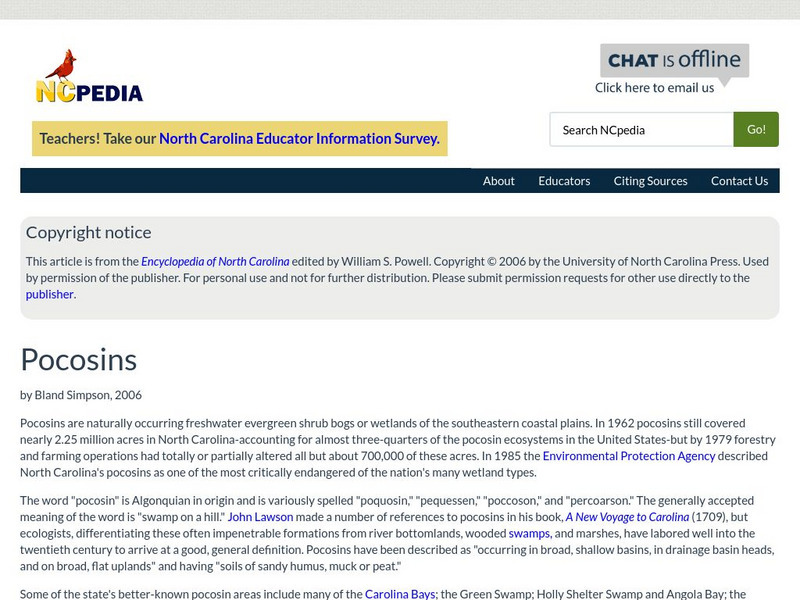Sophia Learning
Sophia: Freshwater Biomes
This colorful slideshow provides a nice introduction to the freshwater biomes around the world.
Geography 4 kids
Geography4 kids.com: Seasonal Wetlands
Identify the four types of seasonal wetlands found across the earth. There are fresh water and salt water marshes, bogs, and swamps.
Missouri Botanical Garden
Missouri Botanical Garden: Freshwater Ecosystems
At this site from the Missouri Botanical Garden, you can learn about the wide variety of plant and animal life in or around fresh water ecosystems. Click on the links to "wetlands," "Ponds and Lakes," or "Rivers and Streams" to view...
US Geological Survey
Lake Pontchartrain Basin Foundation: Why Worry About Wetland?
Help students understand the functions and values of wetlands through these multiple intelligences learning activities. The site also includes information about the wetland habitats, commercial values, water quality, and erosion control.
US Fish and Wildlife Service
U.s. Fish and Wildlife Service: Wetlands, Marshes, Tracks in the Mud
This resource presents information about wetland ecosystems and the importance of habitat conservation in this resource and then try an interactive activity to identify tracks of wetland animals.
Other
Adopt a Pond Wetland Curriculum Resource
The Adopt-A-Pond Program was created by the Toronto Zoo for teachers looking for a guide to wetland issues and resources.
Sophia Learning
Sophia: Freshwater Biomes: Lesson 2
This lesson will provide an understanding of the characteristics and role of freshwater biomes, and its effect on living things. It is 2 of 4 in the series titled "Freshwater Biomes."
BiologyWise
Biology Wise: Freshwater Biome Plants
Brief overview of types of freshwater biomes and the plants that live in them, as well as adaptations that plants have made in order to survive there.
Ducksters
Ducksters: Science for Kids: Freshwater Biome
Kids learn about the freshwater aquatic biome. Ecosystems such as rivers, streams, ponds, lakes, wetlands, swamps, and bogs.
Other
Grid Adrenal: Global Freshwater Resources: Quantity and Distribution by Region
Glaciers and icecaps contain approximately 70% of the world's freshwater, but groundwater is by far the most abundant and readily available source of freshwater. This graphic illustrates the quantity (in cubic kilometres) and...
Other
Freshwater Ecology
This is a comprehensive and detailed site providing information on aquatic macroinvertebrates. The emphasis is on biomonitoring of water quality through quantitative assessment of numbers and types of small aquatic organisms.
US Geological Survey
U.s. Department of Interior: Lake Pontchartrain Basin Lessons
An entire unit regarding the wetlands of the Lake Pontchartrain Basin. Students can find comparisons or relationships between elevation, vegetation, soils, geologic formations, rainfall, pollution, public land use, coastal wetlands,...
Center for Educational Technologies
Nasa Classroom of the Future: Florida Everglades
This site is full of information and activities to help learn about the Florida Everglades, a unique wetland environment, and its future.
University of California
Ucmp: The World's Biomes
This is an introduction to the major biomes on Earth. This page groups biomes into five major types: aquatic, deserts, forests, grasslands, and tundra. Information on climate, animal/plant life, and much more is given for each of type...
NASA
Climate Kids: 10 Interesting Things About Ecosystems
Discover 10 interesting things about ecosystems, including features of coral reefs, rainforests, deserts, grasslands, freshwater ecosystems, the tundra, the ocean floor, wetlands, boreal forests and big cities.
CK-12 Foundation
Ck 12: Life Science: Aquatic Biomes
[Free Registration/Login may be required to access all resource tools.] Aquatic biomes can be generally classified based on the amount of salt in the water. Freshwater biomes have less than 1% salt and are typical of ponds and lakes,...
TED Talks
Ted: Ted Ed: What's So Great About the Great Lakes?
The North American Great Lakes- Huron, Ontario, Michigan, Erie, and Superior- are so big that they border 8 states and contain 23 quadrillion liters of water. They span forest, grassland, and wetland habitats, supporting a region that's...
Other
Alberta Riparian Habitat Management: Protecting Shorelines & Streambanks [Pdf]
Protecting Shorelines & Streambanks - Naturally explains the critical importance of healthy shorelines for preventing soil erosion and filtering out pollutants. It looks specifically at riparian areas, such as those in Alberta, which...
Other
Alberta Riparian Habitat Mgt Society: Biodiversity and Riparian Areas [Pdf]
Healthy riparian areas have much higher levels of biodiversity than other types of ecosystems, as explained in this fact sheet. Unfortunately, this also attracts more people, which can contribute to degradation of the ecosystem if the...
CK-12 Foundation
Ck 12: Biology: Biomes Study Guide
This comprehensive study guide covers the main terms and concepts needed for a unit on biomes.
State Library of North Carolina
N Cpedia: Pocosins
Pocosins are naturally occurring freshwater evergreen shrub bogs or wetlands of the southeastern coastal plains. In 1962 pocosins still covered nearly 2.25 million acres in North Carolina-accounting for almost three-quarters of the...
Curated OER
Unesco: Brazil: Pantanal Conservation Area
The Pantanal Conservation Complex consists of a cluster of four protected areas with a total area of 187,818 ha. Located in western central Brazil at the south-west corner of the State of Mato Grosso, the site represents 1.3% of Brazil's...
University of Florida
Florida Museum of Natural History: About the Florida Everglades
Everything you always wanted to know about the Everglades! The Florida Museum of Natural History offers great photos and good information on the many habitat types to be found there.
BBC
Bbc Nature: Wildlife: Swamp
Take a close-up look at the world of swamps and discover what lives and grows there through pictures, descriptions, and external links. Listen to the various sounds made in swamps in different locations.


